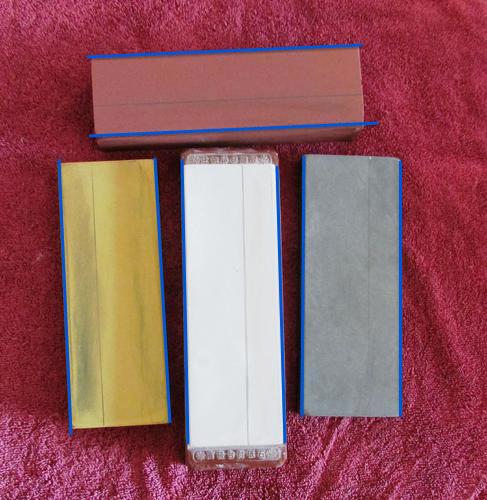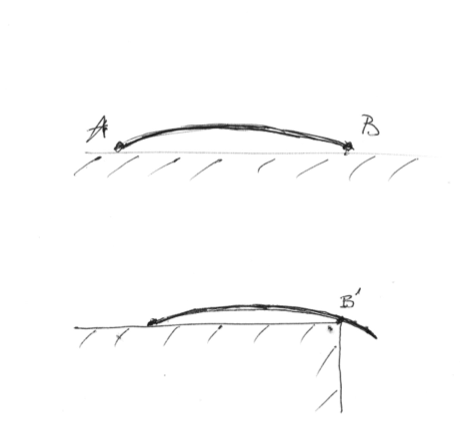Results 21 to 30 of 62
-
02-24-2016, 11:29 PM #21

I've never heard an argument about narrow hones for some abstract 'difficult edges', but I've always heard that narrow hones are needed to deal with concavity of warped razors (and frowning ones if you keep the frown). Smiling razors are anything but difficult compared to warped ones.
Honestly, I don't really understand the value in your suggestion - concentrating on using a 1" width of a hone. The only way I can see how it can be helpful is by indirectly making the person to pay attention at the contact point between the razor and the hone by telling them to try to focus everything in a small area.
To me it makes a lot more sense to point them directly to the actual thing that matters - paying attention to the contact point, which is what I've always suggested and I had the impression that it had become the standard advice.
-
02-24-2016, 11:57 PM #22At this point in time...




- Join Date
- Jun 2007
- Location
- North Idaho Redoubt
- Posts
- 27,029
- Blog Entries
- 1
Thanked: 13245
And yet the exact same suggestion is given multiple times on SRP by multiple people ...
Don't know why you haven't noticed it over the years because it helps people realize that it works
For this reason
These are the types of posts I am talking about out there:
I am not going to link it so as not to embarrass anyone but it is from SRP
These smiling wedges take ages if you try to hone them on 2 or 3 inch wide hones. You really need a narrower hone. In the olden days most honing was done on narrow hones anyway. Wide (natural) hones were simply more expensive! Synthetic hones were only introduced much later. If you have an old, used razor it most likely was honed with a narrow hone.
If you use a wide hone on a smile you'll find you do not hone the whole length of the bevel. Do the bevel marking test and you'll see imediately if that's the case.
You wil have to remove more metal honing a wedge. Presuming you apply similar pressure when honing on a narrow or wide hone the pressure per inch of bevel will be more if you use a narrow hone, so that'll speed up things. When you start popping hairs reduce the amount of slurry and finish without.
If you do not want to cut your Norton up use a narrow coticule or Belgian blue with lots of slurry.
My 2 cts.
Last edited by gssixgun; 02-25-2016 at 12:14 AM.
-
02-25-2016, 12:09 AM #23

I'm certainly not going to object to 'I don't understand what I'm doing but it just works' in the absence of something more useful.
I just find it odd and somewhat unsatisfactory when it's all that is on offer from people who aspire to be experts not only in 'doing something well' but also in 'understanding what they are doing'.
-
02-25-2016, 12:19 AM #24At this point in time...




- Join Date
- Jun 2007
- Location
- North Idaho Redoubt
- Posts
- 27,029
- Blog Entries
- 1
Thanked: 13245
Also can you please define
"The edge of the Hone"
-
02-25-2016, 12:23 AM #25

I think it's splitting hairs to say exactly what part of the hone you are using eg. the edge or 'x' millimetres near the edge.
The degree of the warp's concavity will determine the contact points & you may well be using the same area as a narrow hone.The white gleam of swords, not the black ink of books, clears doubts and uncertainties and bleak outlooks.
-
02-25-2016, 12:35 AM #26

It means what you think it means - the blue lines on the picture (from the original post):

It's not hard to see why - when you place the convex profile of the razor edge on top of a flat hone it will touch the hone in only two points. Only if one of these points is the edge of the hone you can move the whole arc of the razor edge over it.
If you do the experiment I suggested the concave parts of your razor will never be able to make contact with the hone.
You can alternatively use a convex hone or if the razor has enough flex you can push it down to contact the hone but the later makes controlling the amount of pressure extremely difficult and thus nearly impossible to obtain a shave-worthy edge that way.Last edited by gugi; 02-25-2016 at 12:38 AM. Reason: concave hone or flex
-
02-25-2016, 12:43 AM #27At this point in time...




- Join Date
- Jun 2007
- Location
- North Idaho Redoubt
- Posts
- 27,029
- Blog Entries
- 1
Thanked: 13245
Yeah it would have to be a pretty severe warp to need to go there... But yea it would work I would REALLY make sure the edge was Chamfered well before I did though
-
02-25-2016, 01:00 AM #28

It's not about severe warps or that 'it would work as well', I am saying that this is how it does work - there is nothing else.
If the curvature of the 'warp' is comparable with the imperfections of the hone's flatness then there is no warp by definition. Because nothing is mathematically perfect warp is by definition when the razor's geometry is so far away from flat that it does not make contact with a flat hone.
Here, I sketched it quickly:

That's why I think the best advice is to tell people where the honing action happens, and depending on the specificities of the razor they should figure out a stroke that can draw the whole edge across the hone with uniform pressure. That's what honing a razor boils down to.
-
02-25-2016, 01:09 AM #29At this point in time...




- Join Date
- Jun 2007
- Location
- North Idaho Redoubt
- Posts
- 27,029
- Blog Entries
- 1
Thanked: 13245
Not sure what part of that you missed... That is exactly what I said,
You have just moved it to a specific honing issue when the thread was actually about all honing issues that people think they need a thin hone for...
By simply drawing the line it helps to visualize that movement...Last edited by gssixgun; 02-25-2016 at 01:26 AM.
-
02-25-2016, 01:36 AM #30

The issue is the apparent misunderstanding of the simple geometry of honing leading some people to claim they need narrow hones and others to counter them that such hones are unnecessary because 'you can use any part of a wide hone just like you'd use a narrow hone'.
This is simply not true. First, what makes some razors much more difficult to hone is concavity - convexity pales in comparison with it. And the only way to hone such razor is using the edge of the hone.
Now, if you understand what is going on you can actually draw correct conclusions about what is important and what isn't. One of them is that it is not important at all to have a narrow hone. Another is to ensure that the edge of your hone is smooth. Another is during honing to focus on the edge of the hone because that's where the contact with the razor is. This last one is particularly important because you don't have the same visual feedback from a water beed as you have when you hone a convex razor on the middle of the hone.
Those, and probably many other useful tips can be derived simply from understanding the process and not by throwing stuff at the wall to see what sticks.
Plus the whole thing of 'you can just as well use the middle of the hone' is plain wrong and definitely worth noting.
There are arguments like 'I prefer this hone to that one' that are never going to end. But arguments about the need of narrow hones can and should end. The only reason I can think that it hasn't happened is that instead of understanding the issue and ending it once and of all, some people have been offering false arguments.
It is the difference between settling that 2+2 isn't 3 because it is 4 and arguing that it isn't 3 because it is 3.5.


 108Likes
108Likes LinkBack URL
LinkBack URL About LinkBacks
About LinkBacks








 Reply With Quote
Reply With Quote